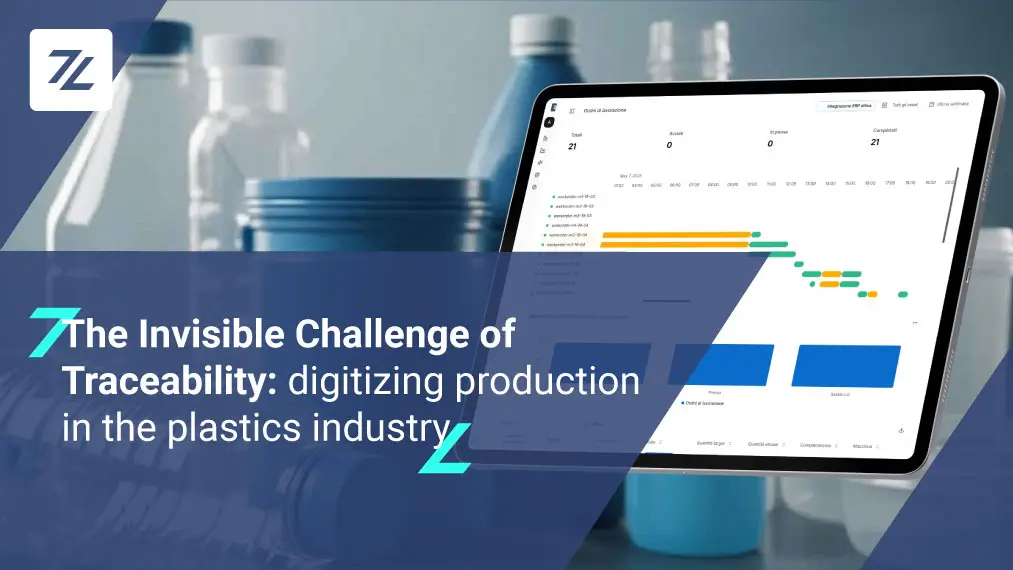Plastic is used in various industrial sectors. Using AI technology is necessary for correct machinery functioning in order to predict possible damage and malfunctions. This prevents operation problems, reduces downtime, and intervention costs. Maintenance 4.0 makes this possible.
Every year, millions of tons of plastic are created for various industrial processes. It is imperative that companies can respond to the high demand for plastic materials, through sustainable processes, both with respect to the environment and from an economic point of view.
Making processes more efficient, optimizing production, and reducing costs allows companies to adequately manage their production. Being able to predict damage and breakdowns, furthermore, provides a strong advantage for companies looking for technologies that are capable of reducing machine downtime as they implement Maintenance 4.0 techniques.
Why use IoT technology in the plastics sector? In the last blog post we addressed energy-efficient processes in the plastics sector with the IoT, however, we will now talk about the advantages of predictive maintenance and Industry 4.0, focusing specifically on injection molding.
The plastics sector: an overview
Because plastics production is mainly linearly produced fails to meet the numbers expected by the recyclable economy. According to an SYSTEMIQ report, only 15% of plastic production actually derive from recycled materials.
The sector in Europe exceeds 360 billion euros in turnover with 310 million tons produced annually. Plastic materials are used in multiple industries like packaging, construction, medicine, aerospace, automotive, and electronics.
With rising energy costs, however, production in the plastics sector has declined. The impact of these costs could reach 8.8% in 2022 for Italian companies, as shown in Fig. 1.
Fig. 1. Confindustria – Impact of energy costs in the manufacturing sector
Although the sector is mostly made up of medium or small-sized industries, it is intensely devoted to research and innovation because of the many challenges coming from the rest of the world. This includes competition from China, and India, from the extraction of shale oil and shale gas by the USA.
Faced with these challenges, the Italian plastics industry has to be competitive by becoming ever increasingly “smart”. This is possible with transitioning to Industry 4.0 which bases production on intelligent technologies, all interconnected, and controlled by a central system. Furthermore, it is competitively advantageous to embrace Maintenance 4.0 techniques which allows companies to benefit immensely and save on maintenance costs.
Injection molding: what it is and how it works
Plastic is used in the production of countless products that have different applications and geometries. Parameters like shape, volume, production time and materials of the product require different production methods:
- Injection presses/printers
- Production machinery
- Heating and cooling machinery
- Finishing machinery
- Injection mold cleaning machinery
Injection molding consists of melting plastic pellets which, once they become malleable, are injected under pressure into the cavities of a mold which are filled and solidify to obtain the final product, as shown in Fig. 2.
Fig. 2 Injection molding press
This type of machinery is used for the production of hollow products such as bottles and flasks, and for producing large quantities of identical parts using a single mold.
Unfortunately, injection molding machines have safety problems because accidents at work are frequent. Major dangers are that some parts of the body can be crushed by moving mechanical components. Burns and noises that harm hearing are also problems.
Using IoT technologies allows implementation of maintenance techniques 4.0, thus guaranteeing greater safety for workers and reducing the risk of accidents at work. Predicting when machinery breaks down, for example, allows you to monitor safety conditions in the workplace and keep an eye on the reliability of the machines, thus avoiding harmful consequences for workers.
Maintenance 4.0 in the plastics sector: the main advantages
Planned maintenance, also called programmed maintenance, is a consolidated methodology in the industrial field that presents a proactive approach to maintenance. Carefully monitoring the machinery and studying the data and process history allows intervention even before the failure occurs.
By integrating IoT technologies, machine learning and artificial intelligence (AI), it is possible to implement 4.0 or predictive maintenance techniques. This type of maintenance is more efficient and effective than preventive maintenance: in fact, because of the continuous observation in operating status of the machinery with the IoT, and real-time and automated analysis of the machinery’s state of health, it is possible to identify all operating time before failure.
This differs from planned maintenance in that it looks at the actual condition of the equipment to predict when maintenance will be needed. In Fig. 3 we can see a diagram on the main characteristics for the different types of maintenance.
Fig. 3 The different types of maintenance
By implementing maintenance techniques 4.0, it is possible to reduce the number of maintenance operations and optimize execution: in this way, repairs can be managed more efficiently, resulting in increased operating time.
This allows for a reduction in machine blocking times, thus maintaining the same results during production. In addition, the actual maintenance required is minimized and failures never arise because they can be predicted and acted upon before they occur.
This also leads to a reduction in management costs, an optimization of machine availability, increased machine performance, and product quality. In this way, maintenance becomes an integral part of your company strategy and we can speak of data driven maintenance.
Zerynth’s solution for Maintenance 4.0
Zerynth’s Industrial IoT & AI Platform allows you to enable Industry 4.0 on any industrial machinery. Because of IoT technologies it is possible to implement maintenance techniques 4.0 to optimize production and improve the general performance of your machinery.
In fact, these systems make it possible to extract and collect data from industrial machinery, integrate information from different types of machinery, and then display the useful information on personalized dashboards.
With Maintenance 4.0 it is possible to monitor the vibrations of machinery in such a way as to collect information necessary to create strategies related to combining production and maintenance aspects, thereby, allowing you to predict failures hours in advance for prompt intervention.
Watch the on-demand webinar to find out how Armal’s production line IoT monitoring system has made it possible to reduce their energy costs for their machinery by 40% and recover their investment in just 4 months.
Share This Story, Choose Your Platform!
Follow Zerynth on
Latest Posts








